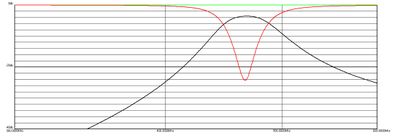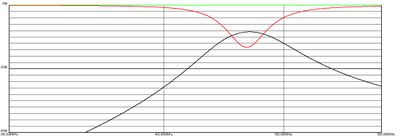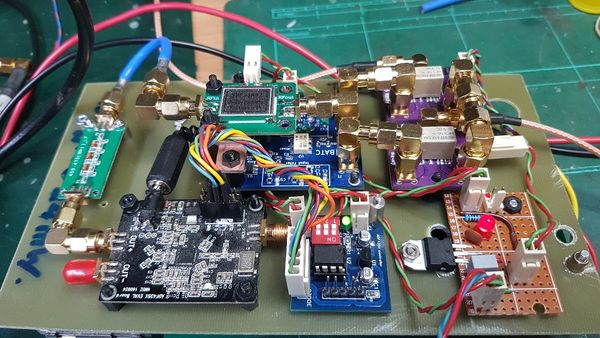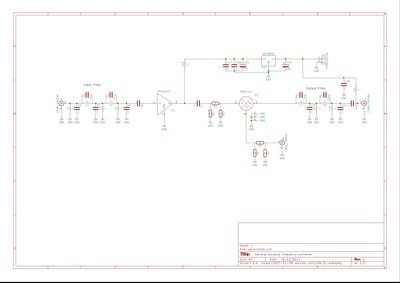Difference between revisions of "71 MHz"
(→Equipment for 71MHz DATV: cost of a converter system) |
|||
| (28 intermediate revisions by 4 users not shown) | |||
| Line 1: | Line 1: | ||
| − | + | Following access to and progress in the 146-147 MHz band, access for further digital experimentation was negotiated in 2015 to the 70.5-71.5 MHz range, centred on 71.0 MHz. Originally Full licencees had to apply for a Special Research Permit (SRP) using a manual paper process and a number of operators reported problems with their application getting stuck etc. | |
| − | + | Following further negotiation, in June 2018 it became more easily available as an annually-renewable NoV available to holders of the Full UK licence. Applications are now done on-line in a similar process to the 146MHz NoV and result in an NoV being issued immediately. See:- | |
| + | |||
| + | * NoV Form: http://rsgb.org/main/operating/licensing-novs-visitors/online-nov-application/70-5mhz-and-71-5mhz-nov/ | ||
| + | * Additional RSGB guidance on 146 and 71 MHz at https://rsgb.org/main/operating/band-plans/vhf-uhf/vhf-spectrum-release/ | ||
The NoV allows operation with a maximum of 100W ERP, but prohibits operation within 40 km of the coast or border of Scotland. | The NoV allows operation with a maximum of 100W ERP, but prohibits operation within 40 km of the coast or border of Scotland. | ||
| Line 7: | Line 10: | ||
==Equipment for 71MHz DATV== | ==Equipment for 71MHz DATV== | ||
| − | Transmitter | + | ===Transmitter=== |
| + | Portsdown 2018, Portsdown 2019 and DATV Express are all capable of DATV transmissions on 71MHz. | ||
| + | ===Receiver=== | ||
| + | Notes for the G0MJW up-converter from CQ-TV260 are available here. | ||
| + | |||
| + | <u>Schematic</u><br /> | ||
| + | |||
| + | Here is a readable copy of the schematic: | ||
| + | |||
| + | [[File:Schematic.jpg|400px]]<br /> | ||
| + | |||
| + | |||
| + | In the parts list, there may be a bit of confusion over L11 and L15. L11 is only fitted if you are planning to send volts up the coax to provide the bias for the modamp. L15 is the RF choke for the modamp and should be fitted if the PGA103+ modamp is used. You can of course do without the modamp if you have an external pre-amplifier with sufficient gain. Ideally you would run this board just over 2V over the regulator voltage. Using the recommended 3.3V regulator 5V is marginal but probably fine. The PGA103+ takes up to around 100mA. With a 12V supply the regulator will get hot. | ||
| + | |||
| + | The Mini-Circuits Mixer and MMIC amplifiers are stocked by [https://www.minikits.com.au/components/mini-circuits Mini-kits]although an email to Mini-Circuits sales in Surrey (sales@uk.minicircuits.com) would be a best first approach and avoid paying import duty. Update:- Mini-circuits UK advised that applications for EZ Samples of the PGA103+ and ADE-11X+ are acceptable for home constructors. Register with the Mini-Circuits website. Go to the page for one of these parts then press the EZ sample button on the right, fill out the application, reasons and objectives form, add the second item, do the export declaration and press send. Free of charge components arrive a few days later! | ||
| + | |||
| + | |||
| + | <u>SMD Packages</u><br /> | ||
| + | |||
| + | SMD soldering is easy once you get the hang of it, easier than through hole as you don't have to keep turning the board over. I have left a lot of space around each part to aid construction. Don't use a poker, use a fine tip iron and 0.3mm solder. I didn't notice in the proof but the leading zeros have been left off the SMD package, 805 should be 0805. Most of the SMD parts are in the 0805 size, which is often the largest still commonly available. | ||
| + | |||
| + | The pads for the variable capacitors have been extended to allow for larger components which may be easier to use. The Murata TZC03 series for example is an enormous 3.2x4.5mm and the TZB4 an even larger 4x4.5mm. | ||
| + | |||
| + | The dot on the ADE11x mixer indicates pin 1 and should align with the 1 on the silkscreen. | ||
| + | |||
| + | <u>Other output frequencies</u><br /> | ||
| + | For other output frequencies, the filter will tune from around 400MHz upto about 700MHz. For lower output frequencies increase the 3.3nH inductor, e.g. to 3.9nH. For higher frequencies reduce it. The tuning is fairly sharp so take your time and do not under any circumstances even consider using a metal screwdriver to tune it up. | ||
| + | |||
| + | <u>Other input frequencies</u><br /> | ||
| + | There is no reason to be limited to 50-70MHz. This will work at 2m too but the input filter will need to be modified, ideally to a band pass to keep out the broadcast band. The board had been designed to allow several different filter topologies. | ||
| + | |||
| + | <u>Modamp</u><br /> | ||
| + | You do not have to use a PGA-103+. Other similar devices like the SPF5189z will work. If you already have a pre-amplifier with sufficient gain, say 20dB or more, the modamp can be bypassed and there is no need for a power supply or regulator. | ||
| + | |||
| + | <u>Impact of inductor Q</u><br /> | ||
| + | |||
| + | Not all SMD inductors are of the same quality factor (Q). For filters it is important to use high Q components, otherwise the filter will be lossy and may not have the expected performance. The two 3.3nH inductors in the output filter are probably the most critical, parts are preferred with a Q of 30 or more and will result in a filter loss of 4-5dB. Not great, but a fair compromise. If you use low Q inductors, (some cheaper ones are as low as 10), it will work, but the output filter will have more loss. | ||
| + | |||
| + | Good inductor Q = 38, e.g. AVX L08053R3DEWTR or Coilcraft 0805CS-030XJLC | ||
| + | <br /> | ||
| + | |||
| + | [[File:BPFQ38.jpg|400px]] | ||
| + | <br /> | ||
| + | Moderate inductor Q = 16 | ||
| + | <br /> | ||
| + | [[File:BPFQ16.jpg|400px]] | ||
| + | <br /> | ||
| + | Awful inductor Q = 10 | ||
| + | <br /> | ||
| + | [[File:BPFQ10.jpg|400px]] | ||
| + | |||
| + | [https://youtu.be/D9r-Zb_YhsU A video of an upconverter in action by David M0YDH is here.] | ||
| + | |||
| + | THis picture shows a later upconverter system built by M0YDH. Clockwise from bottom right:- 12V in and 5V regulated supply // BATC PIC card with program for 400MHz to control the sysnthesiser // ADF4351 synthesiser as LO // EBay 400- 470 MHz low pass filter // SPF5189Z amp // G0MJW upconverter card with -6dB attenuation// pair of G0MJW RF SPDT relay boards / The Normally Closed bypass line in SMA fittings. One switch on the unit front panel when turned on energises the upconverter. The other side of the plain PCB card has a Minitioune v1.5 mounted on it. | ||
| + | |||
| + | [[File:M0YDH Upconverter.jpg|600px]] The assembly shown cost about £85 to put together in 2022 [the ADF4351 was bought for £10 secondhand] | ||
| + | |||
| + | ===Antennas=== | ||
| + | Before buying or building a beam here are two low cost designs to get you onto the band | ||
| + | |||
| + | 1) [https://sites.google.com/site/gw7aav2/70mhz(4metre)deltaloop A 4m delta loop by Steve GW7AAV]. David M0YDH made one of these some years ago for SOTA and it was a VSWR approaching 1:1 straight away. Old TV coax is used for the matching section. Electrical conduit is used for the boom [not flimsy waste water pipe!]. You could fasten two mini telescopic masts to a plastic bread board with pipe clamps to support the wire triangle. [https://sites.google.com/site/gw7aav2/50mhzdeltaloop There is a 6m version on the site too.] Also a combined pair of these antennas are shown on the 4m page. | ||
| + | |||
| + | 2)[http://www.70mhz.org/coaxdipole.htm A centre-fed "co-axial" dipole for 4m by Tony G4CJZ] was built quickly be Noel G8GTZ with acceptable results to get on the band. | ||
| + | |||
| + | ===Filters=== | ||
| + | These are in the [[70MHz_filters|Filters section of this Wiki]]. | ||
Latest revision as of 19:24, 9 September 2022
Following access to and progress in the 146-147 MHz band, access for further digital experimentation was negotiated in 2015 to the 70.5-71.5 MHz range, centred on 71.0 MHz. Originally Full licencees had to apply for a Special Research Permit (SRP) using a manual paper process and a number of operators reported problems with their application getting stuck etc.
Following further negotiation, in June 2018 it became more easily available as an annually-renewable NoV available to holders of the Full UK licence. Applications are now done on-line in a similar process to the 146MHz NoV and result in an NoV being issued immediately. See:-
- NoV Form: http://rsgb.org/main/operating/licensing-novs-visitors/online-nov-application/70-5mhz-and-71-5mhz-nov/
- Additional RSGB guidance on 146 and 71 MHz at https://rsgb.org/main/operating/band-plans/vhf-uhf/vhf-spectrum-release/
The NoV allows operation with a maximum of 100W ERP, but prohibits operation within 40 km of the coast or border of Scotland.
Equipment for 71MHz DATV
Transmitter
Portsdown 2018, Portsdown 2019 and DATV Express are all capable of DATV transmissions on 71MHz.
Receiver
Notes for the G0MJW up-converter from CQ-TV260 are available here.
Schematic
Here is a readable copy of the schematic:
In the parts list, there may be a bit of confusion over L11 and L15. L11 is only fitted if you are planning to send volts up the coax to provide the bias for the modamp. L15 is the RF choke for the modamp and should be fitted if the PGA103+ modamp is used. You can of course do without the modamp if you have an external pre-amplifier with sufficient gain. Ideally you would run this board just over 2V over the regulator voltage. Using the recommended 3.3V regulator 5V is marginal but probably fine. The PGA103+ takes up to around 100mA. With a 12V supply the regulator will get hot.
The Mini-Circuits Mixer and MMIC amplifiers are stocked by Mini-kitsalthough an email to Mini-Circuits sales in Surrey (sales@uk.minicircuits.com) would be a best first approach and avoid paying import duty. Update:- Mini-circuits UK advised that applications for EZ Samples of the PGA103+ and ADE-11X+ are acceptable for home constructors. Register with the Mini-Circuits website. Go to the page for one of these parts then press the EZ sample button on the right, fill out the application, reasons and objectives form, add the second item, do the export declaration and press send. Free of charge components arrive a few days later!
SMD Packages
SMD soldering is easy once you get the hang of it, easier than through hole as you don't have to keep turning the board over. I have left a lot of space around each part to aid construction. Don't use a poker, use a fine tip iron and 0.3mm solder. I didn't notice in the proof but the leading zeros have been left off the SMD package, 805 should be 0805. Most of the SMD parts are in the 0805 size, which is often the largest still commonly available.
The pads for the variable capacitors have been extended to allow for larger components which may be easier to use. The Murata TZC03 series for example is an enormous 3.2x4.5mm and the TZB4 an even larger 4x4.5mm.
The dot on the ADE11x mixer indicates pin 1 and should align with the 1 on the silkscreen.
Other output frequencies
For other output frequencies, the filter will tune from around 400MHz upto about 700MHz. For lower output frequencies increase the 3.3nH inductor, e.g. to 3.9nH. For higher frequencies reduce it. The tuning is fairly sharp so take your time and do not under any circumstances even consider using a metal screwdriver to tune it up.
Other input frequencies
There is no reason to be limited to 50-70MHz. This will work at 2m too but the input filter will need to be modified, ideally to a band pass to keep out the broadcast band. The board had been designed to allow several different filter topologies.
Modamp
You do not have to use a PGA-103+. Other similar devices like the SPF5189z will work. If you already have a pre-amplifier with sufficient gain, say 20dB or more, the modamp can be bypassed and there is no need for a power supply or regulator.
Impact of inductor Q
Not all SMD inductors are of the same quality factor (Q). For filters it is important to use high Q components, otherwise the filter will be lossy and may not have the expected performance. The two 3.3nH inductors in the output filter are probably the most critical, parts are preferred with a Q of 30 or more and will result in a filter loss of 4-5dB. Not great, but a fair compromise. If you use low Q inductors, (some cheaper ones are as low as 10), it will work, but the output filter will have more loss.
Good inductor Q = 38, e.g. AVX L08053R3DEWTR or Coilcraft 0805CS-030XJLC

Moderate inductor Q = 16

Awful inductor Q = 10

A video of an upconverter in action by David M0YDH is here.
THis picture shows a later upconverter system built by M0YDH. Clockwise from bottom right:- 12V in and 5V regulated supply // BATC PIC card with program for 400MHz to control the sysnthesiser // ADF4351 synthesiser as LO // EBay 400- 470 MHz low pass filter // SPF5189Z amp // G0MJW upconverter card with -6dB attenuation// pair of G0MJW RF SPDT relay boards / The Normally Closed bypass line in SMA fittings. One switch on the unit front panel when turned on energises the upconverter. The other side of the plain PCB card has a Minitioune v1.5 mounted on it.
 The assembly shown cost about £85 to put together in 2022 [the ADF4351 was bought for £10 secondhand]
The assembly shown cost about £85 to put together in 2022 [the ADF4351 was bought for £10 secondhand]
Antennas
Before buying or building a beam here are two low cost designs to get you onto the band
1) A 4m delta loop by Steve GW7AAV. David M0YDH made one of these some years ago for SOTA and it was a VSWR approaching 1:1 straight away. Old TV coax is used for the matching section. Electrical conduit is used for the boom [not flimsy waste water pipe!]. You could fasten two mini telescopic masts to a plastic bread board with pipe clamps to support the wire triangle. There is a 6m version on the site too. Also a combined pair of these antennas are shown on the 4m page.
2)A centre-fed "co-axial" dipole for 4m by Tony G4CJZ was built quickly be Noel G8GTZ with acceptable results to get on the band.
Filters
These are in the Filters section of this Wiki.
